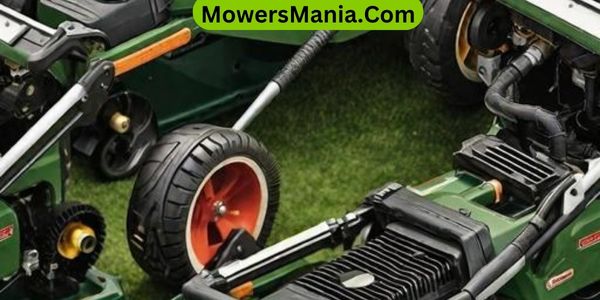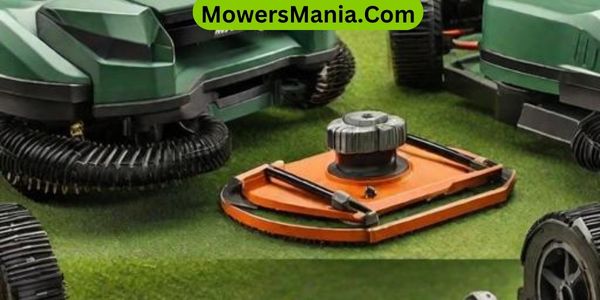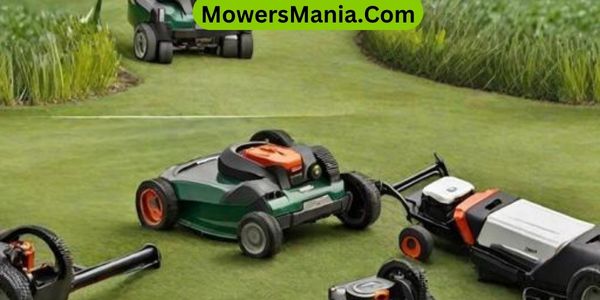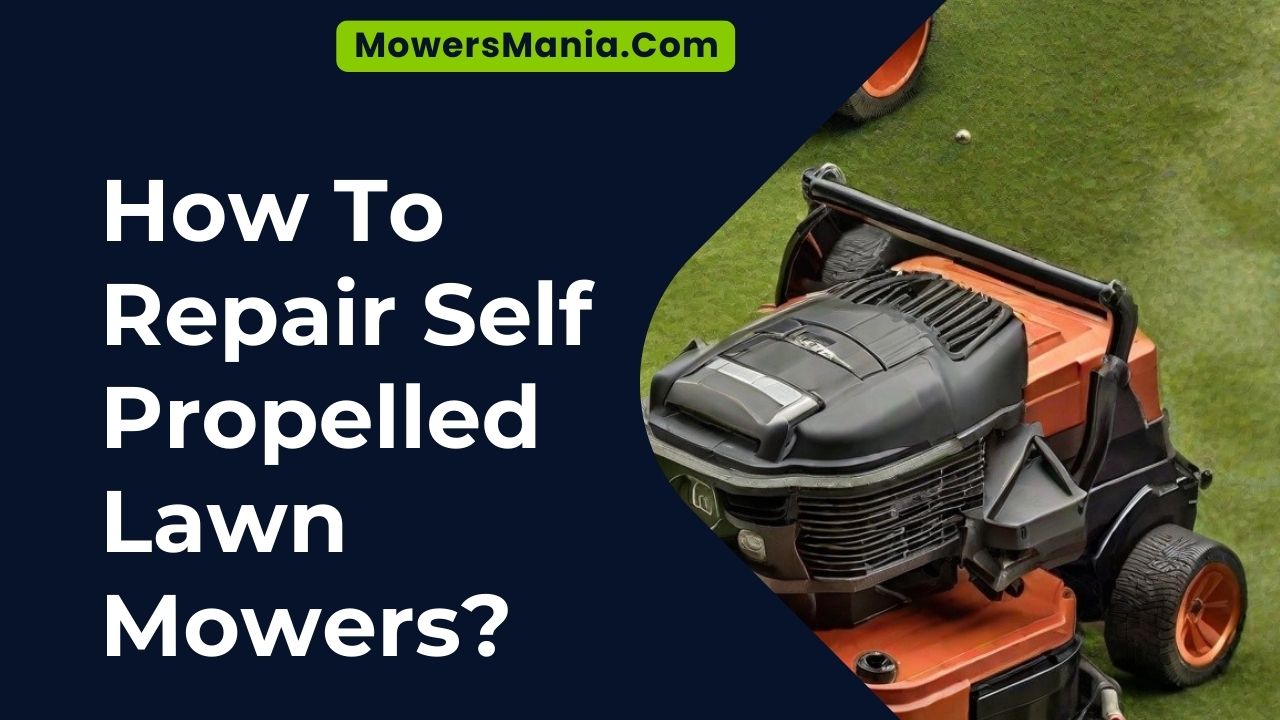If your self propelled lawn mower is not running smoothly, don’t worry! You can easily repair it yourself.
In this article, we’ll show you how to fix common issues such as a loose drive belt, a dirty spark plug, or a clogged air filter.

We’ll also guide you through adjusting the drive control cable, sharpening or replacing the blade, and lubricating the wheels and axle.
With a little bit of effort, your lawn mower will be back in action in no time.
Checking the Drive Belt
To check the drive belt on your self propelled lawn mower, start by removing the mower’s cover plate. This plate is usually located on the top or the side of the mower.
Use a screwdriver or a wrench to loosen and remove the screws or bolts that secure the cover plate in place. Once the cover plate is removed, you’ll have access to the drive belt.
Inspect the drive belt for any signs of wear or damage. Look for cracks, fraying, or any other signs that the belt may need to be replaced. If the belt looks worn or damaged, it’s important to replace it as soon as possible to ensure that your mower operates correctly.
To remove the drive belt, locate the tensioner pulley. This pulley is responsible for keeping the belt tight. Use a socket wrench to loosen the tensioner pulley and release the tension on the belt. Once the tension is released, you can easily remove the drive belt from the pulleys.
When installing a new drive belt, make sure to follow the manufacturer’s instructions. Route the belt around the pulleys and then tighten the tensioner pulley to ensure a proper fit. Finally, reinstall the cover plate and tighten the screws or bolts to secure it in place.
Inspecting the Spark Plug
Once you have checked the drive belt on your self propelled lawn mower, it’s important to inspect the spark plug for any signs of wear or damage.
The spark plug plays a crucial role in the ignition process of your mower’s engine, so keeping it in good condition is essential for optimal performance.
Here are some steps to help you inspect the spark plug effectively:
- Remove the spark plug wire: Start by disconnecting the spark plug wire from the spark plug. This ensures your safety by preventing accidental engine starts while you work on the plug.
- Clean the spark plug: Use a wire brush to gently clean the spark plug. Remove any dirt, debris, or carbon deposits that may have accumulated over time. A clean spark plug promotes better combustion and helps maintain engine efficiency.
- Check the electrode gap: Use a spark plug gap gauge to measure the gap between the center electrode and the ground electrode. Refer to your mower’s manual for the recommended gap specifications. Adjust it if necessary by carefully bending the ground electrode.
- Inspect for signs of wear or damage: Examine the spark plug for any signs of wear, corrosion, or physical damage. If you notice any cracks, erosion, or a worn electrode, it’s best to replace the spark plug with a new one.
Cleaning or Replacing the Air Filter
How can you clean or replace the air filter in your self propelled lawn mower?
The air filter in your lawn mower is an essential component that helps keep the engine running smoothly. Over time, the air filter can become clogged with dirt, debris, and grass clippings, which can restrict airflow and affect the mower’s performance.
To clean the air filter, start by removing it from the mower. Gently tap it against a hard surface to dislodge any loose dirt and debris. If the filter is still dirty, you can wash it with warm soapy water and let it air dry before reinstalling it.
However, if the air filter is damaged or excessively dirty, it’s best to replace it with a new one. To do this, simply remove the old filter and install the new one, making sure it fits securely.
Regularly cleaning or replacing the air filter will help maintain optimal performance and extend the lifespan of your self propelled lawn mower.
Adjusting the Drive Control Cable

To ensure smooth and efficient movement of your self propelled lawn mower, it’s essential to adjust the drive control cable properly.
By making the necessary cable tension adjustments, you can ensure that the mower moves at the desired speed and direction.
This adjustment is crucial for optimal performance and ease of use.
Cable Tension Adjustment
To adjust the tension of the drive control cable on your self propelled lawn mower, start by locating the cable adjustment mechanism. This mechanism is usually located near the handle of the mower and may have a small nut or screw that can be adjusted.
Here are three steps to help you adjust the cable tension effectively:
- Loosen the adjustment nut or screw using a wrench or screwdriver, depending on the type of mechanism.
- Move the cable adjustment mechanism either forward or backward to increase or decrease the tension respectively. This will affect the speed of the mower.
- Tighten the adjustment nut or screw to secure the new tension setting.
Remember to test the mower after making the adjustment to ensure that the drive control cable is properly tensioned and the mower is operating smoothly.
Smooth and Efficient Movement
Achieve smooth and efficient movement by adjusting the drive control cable on your self propelled lawn mower.
The drive control cable is responsible for engaging and disengaging the mower’s wheels, allowing you to easily maneuver it around your yard.
If the cable is too loose, the mower may not move or may move sluggishly. On the other hand, if the cable is too tight, the mower may move too quickly or be difficult to control.
To ensure optimal performance, it’s important to adjust the drive control cable properly.
Refer to the table below for a step-by-step guide on how to adjust the drive control cable on your self propelled lawn mower:
| Step | Instructions | Illustration |
|---|---|---|
| 1 | Disconnect the spark plug wire for safety. |  |
| 2 | Locate the drive control lever and cable. |  |
| 3 | Loosen the cable clamp screw. |  |
| 4 | Adjust the cable tension by moving the cable up or down. |  |
| 5 | Tighten the cable clamp screw securely. |  |
Follow these steps to ensure your self propelled lawn mower moves smoothly and efficiently, making your yard work a breeze.
Sharpening or Replacing the Blade
Now let’s talk about sharpening or replacing the blade of your self propelled lawn mower. Taking care of the blade is essential for a clean and efficient cut.
In this section, we’ll cover some blade maintenance tips, how to choose the right blade, and whether you should sharpen it yourself or seek professional help.
Blade Maintenance Tips
For optimal cutting performance, keep your self propelled lawn mower’s blade sharp by regularly sharpening or replacing it.
Here are some blade maintenance tips to help you maintain your mower’s cutting efficiency:
- Sharpening the Blade:
- Use a file or grinder to remove any dull edges or nicks on the blade.
- Follow the manufacturer’s guidelines for the correct angle and technique while sharpening.
- Make sure to wear safety gloves and goggles to protect yourself during the sharpening process.
- Replacing the Blade:
- Inspect the blade regularly for signs of wear, such as cracks or excessive bending.
- If the blade is damaged beyond repair or has become too thin, it’s time to replace it.
- Always use the recommended replacement blade for your specific mower model to ensure proper fit and functionality.
Choosing the Right Blade
To ensure optimal cutting performance, you should choose the right blade for your self propelled lawn mower by either sharpening or replacing it.
A dull blade can result in an uneven cut and damage to your grass. If your blade is only slightly dull, sharpening it may be sufficient. You can use a file or a grinder to remove any nicks or dents and restore the blade’s sharpness.
However, if the blade is severely damaged or worn out, it’s best to replace it entirely. When choosing a replacement blade, make sure it’s compatible with your specific mower model and matches the original blade’s specifications.
DIY Vs Professional Sharpening
When deciding whether to sharpen or replace the blade on your self propelled lawn mower, you should consider the advantages and disadvantages of DIY versus professional sharpening.
Here are some factors to consider:
DIY Sharpening:
| Pros | Cons |
| Cost-effective option | Requires proper tools and knowledge for effective sharpening |
| Convenience of sharpening the blade at your own pace | Risk of damaging the blade if not done correctly |
| Ability to maintain the blade’s sharpness throughout the mowing season | Time-consuming process |
Professional Sharpening:
| Pros | Cons: |
|---|---|
| Expertise and experience of professionals ensure a high-quality sharpening job | Costlier option compared to DIY sharpening |
| Saves time and effort on your part | May require you to wait for the blade to be sharpened, causing temporary inconvenience |
| Ensures a precise and balanced blade |
Considering these factors will help you make an informed decision on whether to sharpen the blade yourself or seek professional sharpening services.
Lubricating the Wheels and Axle

To lubricate the wheels and axle of your self propelled lawn mower, gather your lubricant and a clean cloth.
Lubricating the wheels and axle is essential for smooth and efficient operation of your lawn mower. Start by cleaning any dirt or debris from the wheels and axle using the cloth. This will ensure that the lubricant can penetrate properly and provide maximum effectiveness.
Once the wheels and axle are clean, apply a generous amount of lubricant to each wheel and the axle. Be sure to distribute the lubricant evenly and thoroughly. This will help reduce friction and wear on the wheels and axle, extending their lifespan.
After applying the lubricant, give the wheels a few turns to ensure it’s evenly distributed. Lastly, wipe off any excess lubricant using the clean cloth.
Regularly lubricating the wheels and axle won’t only keep your self propelled lawn mower running smoothly, but also prevent unnecessary damage and costly repairs.
Frequently Asked Questions [FAQs]
Can I Use a Regular Wrench to Adjust the Drive Control Cable?
Yes, you can use a regular wrench to adjust the drive control cable on your self propelled lawn mower. Simply locate the adjustment nut and use the wrench to tighten or loosen it as needed.
How Often Should I Clean or Replace the Air Filter?
To keep your self-propelled lawn mower running smoothly, clean or replace the air filter regularly. Neglecting this can lead to poor performance and damage to the engine. Follow the manufacturer’s guidelines for the recommended frequency.
What Type of Oil Should I Use to Lubricate the Wheels and Axle?
To lubricate the wheels and axle of your self-propelled lawn mower, use a high-quality oil that is specifically designed for this purpose. Applying the oil regularly will help maintain smooth and efficient operation.
Can I Sharpen the Lawn Mower Blade Myself or Should I Take It to a Professional?
You can sharpen the lawn mower blade yourself or take it to a professional. It’s up to you. Just make sure you follow the instructions carefully and use the proper tools for the job.
How Can I Tell if the Spark Plug Needs to Be Replaced?
To determine if the spark plug needs replacing, start by removing it. Check for any signs of wear, such as cracks or black deposits. If it looks damaged, it’s time to replace it with a new one.
Conclusion
In conclusion, maintaining and repairing self-propelled lawn mowers is essential for keeping them in good working condition. By regularly checking and replacing the drive belt, spark plug, air filter, and blade, as well as lubricating the wheels and axle, you can ensure optimal performance.
Following these simple steps will help extend the lifespan of your mower and keep your lawn looking its best. So don’t neglect your mower, give it the care it deserves!



